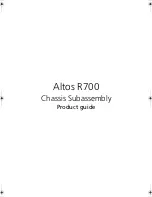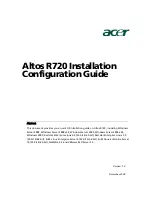
40
158004.B00
4
STAND-ALONE OPERATION AND EXPANSION BUSES
The TP400 will operate as a stand-alone single board computer, or it can use the
PC/104 bus interface to expand its capabilities with the wide range of PC/104 bus I/O
cards currently available. The PC/104-Plus bus allows for expansion using high
speed PCI chips. This section of the manual describes first the stand alone operation
and then operation on the PC/104 and PC/104-Plus buses.
4.1 STAND-ALONE
OPERATION
The TP400 will operate as a single board computer with the addition of the
appropriate peripherals and a 5V power supply. In stand-alone operation the
TP400 need not be plugged into a bus.
The TP400 requires a +5V power supply. Power can be supplied in one of three
ways.
The best option is to use the power connector J101. This is a four pin right-angle
AMP HE14 shrouded header located near the Geode GX1 processor chip. Appendix
E includes pin assignments of this connector and part numbers of suitable mating
connector.
The second option is to use the PC/104 or PC/104-Plus buses. The PC/104 bus
connectors include a number of +5V and GND pins. Some or all of these pins can be
connected in parallel and the res5V and GND connected to the power supply.
This is the way the TP400 would be powered if it was inserted into a motherboard of
the user’s own design.
The third option is to provide power to the board through the 50-way I/O connector
J4. This also includes a number of +5V and GND pins.
Users should take care to provide power to the TP400 through cables that are as
short and thick as possible, and to make use of as many of the power and ground
pins as possible, connecting them in parallel. This is to minimise the voltage drop that
will occur through the resistance of the power cables.
The battery pin must not be connected to +5V and must not be left floating. See
section 3.6 for further details.
4.2 PC/104
BUS
The PC/104 bus is the same from an electrical and timing point of view as the ISA
bus found in PC computers. However it is mechanically different, using a stacking
connector instead of the gold-plated edge connector used in the PC.
The PC/104 interface is via the J1 and J2 connectors along the bottom edge of the
TP400. The 64-way J1 connector provides the 8-bit data bus and the 40-way J2
connector provides the 16-bit signals. The TP400 is able to interface with both the
8-bit and 16-bit modules that meet the PC/104 specification.
Summary of Contents for 104-plus
Page 2: ... This page is intentionally left blank ...
Page 4: ... This page is intentionally left blank ...
Page 76: ...66 158004 B00 This page is intentionally left blank ...
Page 86: ...B8 158004 B00 This page is intentionally left blank ...
Page 88: ...C2 158004 B00 FIGURE C1 MAIN BOARD TOP COMPONENT PLACEMENT ...
Page 89: ...158004 B00 C3 FIGURE C2 MAIN BOARD BOTTOM COMPONENT PLACEMENT ...
Page 90: ...C4 158004 B00 FIGURE C3 DAUGHTER BOARD TOP COMPONENT PLACEMENT ...
Page 91: ...158004 B00 C5 FIGURE C4 DAUGHTER BOARD BOTTOM COMPONENT PLACEMENT ...
Page 92: ...C6 158004 B00 FIGURE C5 MAIN BOARD MECHANICAL DIMENSIONS ...
Page 93: ...158004 B00 C7 FIGURE C6 DAUGHTER BOARD MECHANICAL DIMENSIONS ...
Page 94: ...C8 158004 B00 This page is intentionally left blank ...
Page 100: ...D6 158004 B00 This page is intentionally left blank ...
Page 116: ...E16 158004 B00 This page is intentionally left blank ...
Page 134: ...H6 164004 C03 This page is Intentionally left blank ...
Page 136: ...J2 164004 C03 FIGURE J1 TP400ET MECHANICAL DRAWINGS FIGURE J2 TP400ET CIRCUIT DIAGRAM ...
Page 138: ...K2 158004 B00 FIGURE K1 TP300USB MECHANICAL DRAWINGS FIGURE K2 TP300USB CIRCUIT DIAGRAM ...
















































